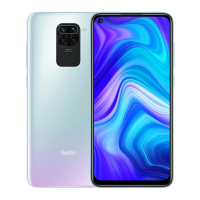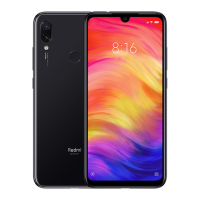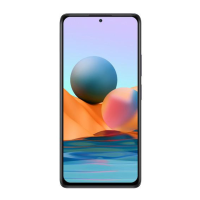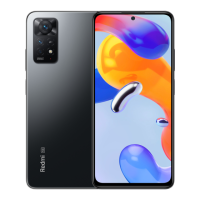Do you have a question about the Xiaomi Redmi Note 9T and is the answer not in the manual?
| Screen shape | Flat |
|---|---|
| Pixel density | 395 ppi |
| Display diagonal | 6.53 \ |
| Touchscreen type | Capacitive |
| Display brightness | 450 cd/m² |
| Display resolution | 2340 x 1080 pixels |
| Native aspect ratio | 19.5:9 |
| Gorilla Glass version | Gorilla Glass 5 |
| Rounded display corners | Yes |
| Contrast ratio (typical) | 1500:1 |
| Form factor | Bar |
| Product color | Purple |
| Multimedia Messaging Service (MMS) | Multimedia Messaging Service (MMS) is a standard way to send messages that include multimedia content to and from a mobile phone over a cellular network |
| Processor cores | 8 |
| Processor family | MediaTek |
| Processor frequency | - GHz |
| Processor boost frequency | 2.4 GHz |
| RAM type | LPDDR4X |
| RAM capacity | 4 GB |
| Compatible memory cards | MicroSD (TransFlash) |
| Internal storage capacity | 64 GB |
| Speakers | stereo |
| Platform | Android |
| Operating system installed | Android 10.0 |
| Flash type | LED |
| Rear camera type | - |
| Front camera type | Single camera |
| Maximum frame rate | 120 fps |
| Video recording modes | 720p, 1080p |
| Rear camera pixel size | 0.8 µm |
| Rear camera aperture number | 1.79 |
| Front camera aperture number | 2.25 |
| Second rear camera pixel size | 1.75 µm |
| Second rear camera focal length | 2.4 mm |
| Rear camera resolution (numeric) | 48 MP |
| Front camera resolution (numeric) | 13 MP |
| Second rear camera aperture number | 2.4 |
| Second rear camera resolution (numeric) | 2 MP |
| Battery capacity | 5000 mAh |
| Cables included | USB Type-C |
| 4G standard | LTE-TDD & LTE-FDD |
| 3G standards | WCDMA |
| SIM card type | NanoSIM |
| Wi-Fi standards | 802.11a, 802.11b, 802.11g, Wi-Fi 4 (802.11n), Wi-Fi 5 (802.11ac) |
| Bluetooth version | 5.1 |
| Bluetooth profiles | A2DP |
| SIM card capability | Dual SIM |
| Mobile network generation | 5G |
| USB version | 2.0 |
| Headphone connectivity | 3.5 mm |
| Depth | 9.05 mm |
|---|---|
| Width | 77.3 mm |
| Height | 161.9 mm |
| Weight | 199 g |
Provides information about the user guide's content and structure.
Important information and precautions to read before operating the handset.
Explains automatic data usage and potential charges for internet connectivity.
Details the function of the volume and power keys on the handset.
Identifies and describes the front and back/side components of the handset.
Covers SIM card handling, cautions, insertion, and removal procedures.
Explains handset storage, SD card compatibility, insertion, and formatting.
Provides instructions and cautions for charging the handset's battery using an AC charger.
Describes the steps for powering the handset on and off.
Guides users through the initial setup wizard after first powering on the device.
Explains how to create or log in to a Google account for device services.
Details how to lock and unlock the handset screen for security.
Explains basic screen navigation and common touchscreen gestures like tap, hold, and swipe.
Describes how to activate silent mode to mute handset sounds and related cautions.
Explains how to enable Airplane mode to disable all wireless functions.
Covers text input methods, including the QWERTY keyboard and character types.
Guides users on checking for and installing software updates for the handset.
Explains indicators and status icons that appear on the top display bar.
Describes the home screen layout, status bar, and navigation bar elements.
Explains the functions of the navigation bar buttons (back, home, history).
Details how to enable auto-rotation for screen orientation changes.
Guides on opening, viewing, and closing the notifications window.
Explains how to access and use quick settings toggles for various functions.
Instructions for making calls, answering incoming calls, and emergency calls.
Discusses phone features like Emergency Location Report, VoLTE, and troubleshooting call issues.
Details available optional phone services like call forwarding, voicemail, and call waiting.
Instructions on how to check the handset's own phone number.
Covers saving new contacts and managing existing contacts.
Information on using the +Message application for communication.
Instructions for creating, sending, and managing emails using the Gmail app.
Guides on using the Chrome browser for searching, browsing, and managing tabs.
Instructions on how to add, edit, and delete web page bookmarks in Chrome.
Details image/video formats, camera cautions, and steps for capturing photos and videos.
Explains how to view photos and videos using the Gallery app.
Covers setting required permissions for applications to function correctly.
Guides on installing free/paid apps from Google Play and managing updates.
Instructions for updating installed applications and setting automatic updates.
Steps for selecting and connecting to a Wi-Fi network.
Instructions for enabling Bluetooth, its cautions, and usage with accessories.
An overview of customizable functions and settings available on the handset.
View handset name, phone number, software versions, and other device information.
Monitor mobile data transfer amounts and set data usage limits.
Customize screen lock methods, sleep delay, and camera launch options.
Adjust display settings like brightness, text size, color scheme, and auto-rotate.
Configure ringtones, alarm sounds, notification tones, and vibration settings.
Customize home screen layout, icons, widgets, and system navigation.
Set screen lock, fingerprint unlock, face unlock, and SIM PIN security features.
Monitor battery usage, optimize power consumption, and manage battery saver modes.
Configure date/time, language, input methods, and accessibility features.
Manage security status, mobile networks, and data roaming configurations.
Information on using the handset globally, including cellular provider and data roaming settings.
Guides on making international calls and accessing roaming services while overseas.
Details the warranty period, repair terms, and after-sales support information.
Lists the technical specifications of the handset and included accessories.
Provides contact information for SoftBank customer support and technical assistance.
Explains safety labels and general warnings for proper handset usage and to prevent damage.
Covers precautions related to physical handling, temperature, and electromagnetic fields.
Warnings and instructions for safely using the AC charger and USB Type-C cable.
Safety information concerning the handling of SIM cards and the SIM removal pin.
Precautions for using the handset near medical devices like pacemakers.
Details about the non-removable internal battery and its disposal.
Important information and cautions related to charging the handset's battery.
Advises on safe usage of the handset while driving, following local regulations.
Explains how to operate the touchscreen and factors affecting its responsiveness.
Discusses compatibility, interference, and frequency bands for Bluetooth and Wi-Fi.
Information regarding copyrights, portrait rights, and content usage restrictions.
Details SAR values and Japanese technical regulations for radio wave exposure.
Information on RF exposure limits and SAR values according to European guidelines.
Explains FCC regulations and SAR values for radio frequency energy exposure.











